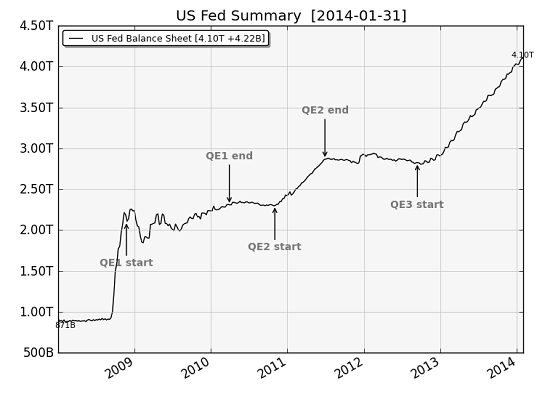The Fed’s policies have been an unqualified success for financiers and an abject failure for the bottom 99.5% who have to work for a living.
After five long years of politicos and the financial media glorifying the Federal Reserve’s policies as god-like in their power and efficacy, let’s take a quick look at the results of these vaunted policies:Â ZIRP (zero interest rates), (QE) quantitative easing, both of which are ways of shoving nearly limitless, nearly-free money ( a.k.a. liquidity) into the banking sector, where all this free money is supposed to filter into the global economy, working miracles of prosperity.
Let’s start with a chart of the Fed’s balance sheet, which reflects just how much money the Fed has created and pumped into the financial system. $4 trillion is larger than the entire GDP of Germany, and roughly 25% of U.S. GDP.
Next, let’s look at the effect of the much-glorified Fed policies on full-time employment:Â If you call a return to the levels of 2005 (despite a 7.5% increase in population) a success, then what would you consider a failure?
Let’s recall that the Fed’s policies are unprecedented. Keeping interest rates near-zero for five years and pumping $4 trillion into the system are both completely off the scale of central bank policy in the U.S.

Next, let’s look at the participation rate–how many people of working age who are actively in the workforce. The trend is ugly; the percentage of the civilian population who are working or actively seeking work is plummeting.

Next: real median household income: this is household income adjusted for inflation.Another ugly chart, as real median household income is back to the levels of 1990. Once again: if you reckon this a success, then what would you consider a failure?

How about the annual change in disposable income? we can assume that “prosperity” and “recovery” mean disposable income are rising at a healthy clip, right? Alas, the rate of disposable income growth is sinking toward zero. The Fed’s policies of bailing out “too big to fail” banks and QE/ZIRP have correlated to the most stunning drop in disposable income growth in decades.

